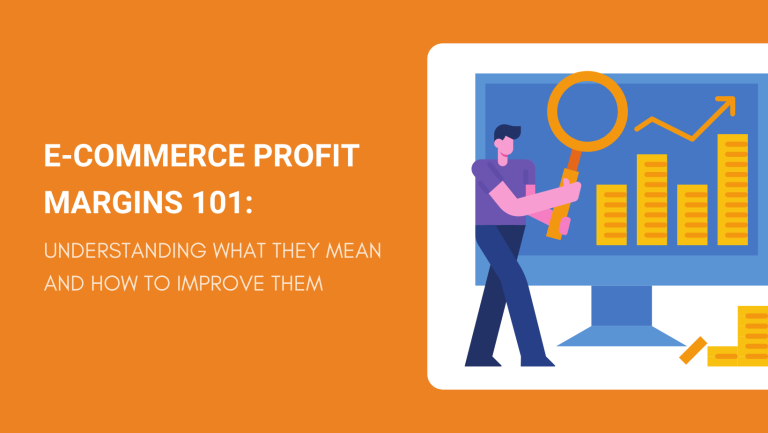E-commerce is immensely popular due to its financial and operational advantages. It, for example, often requires lower start-up costs and tends to have lower overheads and operating costs.
The key upside to these features is that you, the entrepreneur, can enjoy healthier profit margins because the cost of doing business doesn’t take up too much of your revenues.
However, e-commerce profit margins are impacted by various factors and may vary between niches or based on your operational approach.
Read on as we highlight how they work and share tips on fine-tuning your e-commerce business to achieve better profit margins.
Shall we begin?

What Are E-commerce Profit Margins?
An e-commerce profit margin is a percentage that shows how much revenue your online business is making compared to its expenses. It is typically calculated in 2 ways; gross and net profit margins.
Gross Profit Margins
Gross profit margin is a preliminary figure. It only considers how much you have made after sourcing/producing goods and selling them. It does not take into account operating costs.
Take, for illustration, that you are sourcing wholesale sneakers and selling them online.
If you buy the sneakers for $1,000 and sell them for a total of $3,000, your gross profit will be $2,000. In turn, your gross profit margin works out as follows:
(Gross Profit ÷ Total Revenue) × 100= Gross Profit Margin
(2,000÷3,000) × 100= 66.7%
Gross profit may seem superficial because it does not consider expenses. However, it allows you to analyze the sales growth and whether your prices are conducive for profitability before you factor in your expenses.

Net Profit Margin
In contrast, a net profit margin shows how much you have earned after selling goods and meeting the financial obligations of your business.
For context, let us stick to the same example.
While you may have made $2,000 after selling sneakers, you will likely still have other business costs to offset like taxes, the subscription fees for running your online shop, and even advertising expenses.
So, assuming the total of your business expenses is about $300, then your net profit will be $1700 (Gross profit:$2-000 – Business expenses: $300). Subsequently, your net profit margin will be:
(Net Profit ÷ Total Revenue) × 100= Net Profit Margin
(1,700 ÷ 3,000) × 100= 56.7%
Net profit margins are essential for analyzing the health of your business. Adding up your operational costs and comparing them to your revenue can help you identify inefficiencies or areas where you can make changes to improve your bottom line.
Why Are Profit Margins Important?
It is said that numbers do not lie , which rings true when it comes to profit margins. They give you a definitive view of your business and can equally play other key roles. Let us look into a few of them.
A Decision-making Tool

Before venturing into a business niche, a projection of its profit margins can enable you to decide on its viability. Of course, projections are only estimates but it is often much better to use them than go in blind and learn later that you made a poor choice.
On the other hand, evaluating your profit margins when the business is running gives you a chance to see how well different products are selling. Gross profits are especially helpful for this because they can show you how much profit you make per sale.
This can then help you decide which products are worth restocking or if you should explore other products.
Diagnosing Financial Health

Net profit margins, in particular, are vital when it comes to diagnosing the financial health of your business. They show you exactly how much your business earns and whether it is self-sustaining.
Evaluating your net profit margins over time can also show you if your business is growing or not.
Rising or consistent margins are usually an indicator of good business health. Dwindling margins, on the other hand, are often evidence that perhaps your operating costs are too high or that your sales are too low.
What Is a Good Profit Margin for an E-commerce Business?
A good profit margin is one where your business earns enough revenue to sustain itself and support its growth.
Studies show that this can be achieved at a gross profit margin of about 45% for most businesses (both online and physical).
That said, there is no definitive ideal profit margin that can be applied to all e-commerce businesses. This is because online businesses vary based on factors like:
- The scale of the business
- The niche i.e., the type of goods being sold
- The location; the cost of doing business in some countries is higher than in others due to taxes, shipping costs, etc
A better way to find your optimal profit margin would be to set one for yourself based on the specific circumstances of your business. You could, nevertheless, still research and use other successful businesses in your niche as a benchmark.
How to Improve the Profit Margins for Your E-commerce Business
Improving your profit margins is an essential goal for any business. Here are a few tips to help you achieve better numbers.
Increase Your Sales
Higher sales bring in higher revenues. However, it takes some effort to boost your sales. You may need to:
- Invest in advertising- ads drive traffic to your online store which could, in turn, lead to more sales. Targeted ads, in particular, maybe more effective because they reach potential customers that are more likely to buy.
- Run promotional sales– discounts entice shoppers to buy. Even something as simple as free shipping or slashing your price by $5 (if possible) could attract a whole lot of buyers and have you selling out.
- Stock up on popular products- identify the products in your store that customers buy in high volumes and keep them available. Keep track of products that customers request or search for frequently and stock them if you do not have them.
- Offer convenience- a large number of shoppers appreciate being able to get everything at one shop for a fair price. So, try to introduce provisions like gift wrapping, order customization, subscription orders, and customer-friendly payment options.

Get Rid of Inefficiencies
Inefficiencies in your business operations sabotage your profitability. They may eat away at your profits by increasing your operational costs or make your business unsuccessful because customers are not satisfied by the service that you offer them.
Inefficiencies include problems like:
- Unreliable shipping methods
- Complicated check-out systems that cause buyers to abandon carts
- Too many returns and claims for refunds
- Unreliable suppliers
You may not notice business inefficiencies at first but you can weed them out by performing regular appraisals and paying close attention to your monthly or quarterly profit margins.
Try and resolve them as quickly as you can to mitigate the losses that they cause. Do not hesitate to find a better supplier, shipping carrier, or even change your entire system if you reckon it will make things better.
Increase the Value Per Order
Increasing sales can sometimes be a challenge. For instance, if you sell cosmetics, there is only so much sunscreen one person can buy and use at a go.
So, instead, you could work to increase the amount that a buyer spends at your store by:
- Creating product bundles- try to create bundles that include products that a customer can use together and set a slightly discounted price for the bundles. It would entice customers to buy and spend more than if they had just bought one item.
- Suggest add-ons – add-ons are cheaper items that you could suggest to a customer to get them to spend more in your store. For example, if a customer buys a bottle of sunscreen for $35 you could recommend a $5 face mask.

Improve Your Website
A well-organized online store makes it easier for customers to shop. It increases the odds of them buying from your store or recommending it to other shoppers.
Plus, a smooth purchase process reduces cart abandonment which hinders sale conversions.

As such, strive to:
- Upload quality product pictures
- Use accurate and informative product descriptions
- Categorize and tag products appropriately so that they are easy to find
- Make it as simple and direct as possible for a customer to add goods to their cart and check out
Aside from the store’s layout, make an effort to also optimize your online store’s SEO torank higher in online searches. Studies show that customers are more likely to click on higher ranking websites than those towards the bottom.
Reduce Your Business Expenses
At the start of your business, you may have taken up premium subscriptions when setting up your store because you believed that they would be the best option.
However, down the line, it is important to re-evaluate such subscriptions. If they do not offer you great value for money, there is no harm in downgrading them or exploring more affordable or value-adding options.
Consider automating your online business too. It could significantly reduce errors that cause losses in your operations and even allow you to process a higher number of orders more efficiently.
Further, make an effort to address other factors that could increase your expenses such as:
- Shipping expenses- aim for favorable shipping terms, an affordable shipping carrier, and choose a cost-effective method of shipping based on the size of your cargo.
- Manufacturing or product sourcing costs- sourcing products directly from a manufacturer or outsourcing your manufacturing to China or other affordable locations could lower your expenses and raise your profit margins.
Provide Great Customer Service

Great customer service is more than just about solving customers’ problems. It also shows customers how much you value them and determines the kind of shopping experience they get. It entails:
- Responding to questions and complaints promptly
- Being patient and courteous during customer interactions
- Providing actionable solutions and not just lip-service
- Acknowledging failures on your end and making up for them
If you do it right, customers stay loyal to your store and may recommend you to others through positive reviews or word of mouth.
As a result, your business will earn consistent revenues and bring in new clients which all work to improve your profit margins.
FAQs about E-commerce Profit Margins
Are E-commerce Stores Profitable?
Yes, they are.
However, it is important to understand that, like any other business, they are not an overnight success. You have to put in the effort to serve your customers, create a good shopping experience for them, and curate the right collection of products.
Additionally, keep in mind that visibility is crucial in e-commerce. You could have the best online store but if no one knows about it, it is unlikely that you will make any sales let alone profits.
Is E-commerce More Profitable than Retail?
Yes, in most cases, e-commerce is more profitable than retail. This is because:
- Online stores are conveniently accessible to customers anywhere at any time. It is thus easier for them to shop online than to go to a physical shop that could be miles away and is only open at certain hours.
- The costs of running an online store are significantly lower than running a brick-and-mortar. Moreover, it is possible to lower costs even further through options like dropshipping that do not require you to handle inventory.
- An online store could give you access to a wider consumer market than a physical store and subsequently enable you to earn even more.
On the flip side, it is wise to consider that not all products sell well through e-commerce.
Most shoppers have reservations about buying very high-value items online. They may also prefer to buy certain products from a brick-and-mortar if it is cheaper, the shipping cost from an online store is too high, or if the shipping will take too long.
In Conclusion
Running a profitable e-commerce business is highly rewarding and certainly achievable. However, as we have learned in this blog, it requires wise decision-making as well as regular monitoring and optimization of your business operations.
At NicheSources, our services are designed to help you make your business operations as efficient as possible. We can:
- Source products for you from affordable manufacturers
- Find reliable product manufacturers for your brand and negotiate fair manufacturing terms on your behalf
- Handle order fulfillment
- Arrange cost-effective and reliable worldwide shipping
Would you like to streamline your e-commerce venture and achieve better profit margins? Send us a detailed brief of the services you require, request a free quote, and leave the rest to us.

